Monitoring Sand Dune Height Change in Kubuqi Desert Based on a Bistatic InSAR-Measured DEM Differential Method
Highlights
- What are the main findings?
- In the northwestern Kubuqi Desert, bistatic InSAR-derived DEMs were independently validated as the accuracy of about 0.9 m against publicly available ICESat-2 data.
- This study reveals that the average height of dunes in the northwestern Kubuqi Desert decreased by 1.04 m from 26 December 2012 to 25 January 2018 based on the high-precision DEM differential method, which has been proven by the t-test.
- What is the implication of the main finding?
- The actual precision of the two DEMs is likely higher since ground surface variations (such as the melting of snow or change in surface humidity, etc.) present in collected four- or five-month ICESat-2 data possibly lower the inherent accuracy of ICESat-2.
- This study investigated two key factors. Decreased wind energy and increased vegetation coverage have inhibited sediment transport, thereby supporting the dune height decrease.
Abstract
1. Introduction
2. Study Area and Datasets
2.1. Study Area
2.2. Datasets
2.2.1. TanDEM-X InSAR Data
2.2.2. ICESat-2 Data
2.2.3. ERA5-Land Meteorological Dataset
2.2.4. Optical Image Data
3. Monitoring Sand Dune Height Changes Using DEM Differential Technology
4. Results and Analysis
4.1. Estimation and Removal of Orbital Errors
4.2. Reconstruction and Assessment of the Desert Topography
4.3. Identification and Analysis of the Dune Height Change in Kubuqi Desert
5. Discussions
5.1. Sand Dune Movement Patterns
5.2. Vegetation Coverage
6. Conclusions
Author Contributions
Funding
Data Availability Statement
Acknowledgments
Conflicts of Interest
References
- Bruno, L.; Horvat, M.; Raffaele, L. Windblown sand along railway infrastructures: A review of challenges and mitigation measures. J. Wind Eng. Ind. Aerodyn. 2018, 177, 340–365. [Google Scholar] [CrossRef]
- Wang, Z.; Shi, Y.; Zhang, Y. Review of Desert Mobility Assessment and Desertification Monitoring Based on Remote Sensing. Remote Sens. 2023, 15, 4412. [Google Scholar] [CrossRef]
- D’Ettorre, U.S.; Liso, I.S.; Parise, M. Desertification in karst areas: A review. Earth-Sci. Rev. 2024, 253, 104786. [Google Scholar] [CrossRef]
- Hermas, E.; Leprince, S.; El-Magd, I.A. Retrieving sand dune movements using sub-pixel correlation of multi-temporal optical remote sensing imagery, northwest Sinai Peninsula, Egypt. Remote Sens. Environ. 2012, 121, 51–60. [Google Scholar] [CrossRef]
- Ali, E.; Xu, W.; Xie, L.; Ding, X. Assessment of aeolian activity in the Bodélé Depression, Chad: A dense spatiotemporal time series from Landsat-8 and Sentinel-2 data. Front. Environ. Sci. 2022, 9, 808802. [Google Scholar] [CrossRef]
- Zucca, C.; Fleiner, R.; Bonaiuti, E.; Kang, U. Land degradation drivers of anthropogenic sand and dust storms. Catena 2022, 219, 106575. [Google Scholar] [CrossRef]
- Arteaga, C.; Juan de Sanjosé, J.; Serrano, E. Landforms Terrestrial photogrammetric techniques applied to the control of a parabolic dune in the Liencres dune system, Cantabria (Spain). Earth Surf. Process. Landf. 2008, 33, 2201–2210. [Google Scholar] [CrossRef]
- Craddock, R.A.; Tooth, S.; Zimbelman, J.R.; Wilson, S.A.; Maxwell, T.A.; Kling, C. Temporal observations of a linear sand dune in the Simpson Desert, central Australia: Testing models for dune formation on planetary surfaces. J. Geophys. Res.-Planets 2015, 120, 1736–1750. [Google Scholar] [CrossRef]
- Xing, X.; Yang, Z.; Qian, G.; Zhou, G. Real-Time Kinematic Positioning (RTK) for Monitoring of Barchan Dune Migration in the Sanlongsha Dune Field, the Northern Kumtagh Sand Sea, China. Remote Sens. 2023, 15, 4728. [Google Scholar] [CrossRef]
- Mitasova, H.; Overton, M.; Harmon, R.S. Geospatial analysis of a coastal sand dune field evolution: Jockey’s Ridge, North Carolina. Geomorphology 2005, 72, 204–221. [Google Scholar] [CrossRef]
- Derijckere, J.; Strypsteen, G.; Rauwoens, P. Early-stage development of an artificial dune with varying plant density and distribution. Geomorphology 2023, 437, 108806. [Google Scholar] [CrossRef]
- Fabbri, S.; Grottoli, E.; Armaroli, C.; Ciavola, P. Using High-Spatial Resolution UAV-Derived Data to Evaluate Vegetation and Geomorphological Changes on a Dune Field Involved in a Restoration Endeavour. Remote Sens. 2021, 13, 1987. [Google Scholar] [CrossRef]
- Ding, C.; Zhang, L.; Liao, M.; Feng, G.; Dong, J.; Ao, M.; Yu, Y. Quantifying the spatio-temporal patterns of dune migration near Minqin Oasis in northwestern China with time series of Landsat-8 and Sentinel-2 observations. Remote Sens. Environ. 2020, 236, 111498. [Google Scholar] [CrossRef]
- Baird, T.; Bristow, C.S.; Vermeesch, P. Measuring Sand Dune Migration Rates with COSI-Corr and Landsat: Opportunities and Challenges. Remote Sens. 2019, 11, 2423. [Google Scholar] [CrossRef]
- Singh Jasrotia, A.; Ahmad, S.; Ridwan, Q.; Ahmad Wani, Z.; Siddiqui, S.; Siddiqua, A.; Ali Morfeine aika, E. Estimation of Surface Ice Velocity of Durung Drung Glacier, Western Himalaya using COSI-Corr from Landsat images. Egypt. J. Remote Sens. Space Sci. 2024, 27, 369–381. [Google Scholar] [CrossRef]
- Xia, Z.; Lü, P.; Ma, F.; Cao, M.; Yu, J. Quantifying dune migration patterns and influencing factors in the central Sahara Desert. Catena 2024, 235, 107686. [Google Scholar] [CrossRef]
- Dong, Y.; Chang, H.-C.; Liu, J. Measuring Sand Dune Dynamics in the Badain Jaran Desert, China, Using Multitemporal Landsat Imagery. Remote Sens. 2022, 14, 6343. [Google Scholar] [CrossRef]
- Solazzo, D.; Sankey, J.B.; Sankey, T.T.; Munson, S.M. Mapping and measuring aeolian sand dunes with photogrammetry and LiDAR from unmanned aerial vehicles (UAV) and multispectral satellite imagery on the Paria Plateau, AZ, USA. Geomorphology 2018, 319, 174–185. [Google Scholar] [CrossRef]
- Dong, P. Automated measurement of sand dune migration using multi-temporal lidar data and GIS. Int. J. Remote Sens. 2015, 36, 5426–5447. [Google Scholar] [CrossRef]
- Pedersen, A.; Kocurek, G.; Mohrig, D.; Smith, V. Landforms Dune deformation in a multi-directional wind regime: White Sands Dune Field, New Mexico. Earth Surf. Process. Landf. 2015, 40, 925–941. [Google Scholar] [CrossRef]
- Liosis, N.; Marpu, P.R.; Pavlopoulos, K.; Ouarda, T.B.M.J. Ground subsidence monitoring with SAR interferometry techniques in the rural area of Al Wagan, UAE. Remote Sens. Environ. 2018, 216, 276–288. [Google Scholar] [CrossRef]
- Niu, C.; Zhang, H.; Liu, W.; Li, R.; Hu, T. Using a fully polarimetric SAR to detect landslide in complex surroundings: Case study of 2015 Shenzhen landslide. ISPRS-J. Photogramm. Remote Sens. 2021, 174, 56–67. [Google Scholar] [CrossRef]
- Guan, T.; Chang, S.; Deng, Y.; Xue, F.; Wang, C.; Jia, X. Oriented SAR Ship Detection Based on Edge Deformable Convolution and Point Set Representation. Remote Sens. 2025, 17, 1612. [Google Scholar] [CrossRef]
- Havivi, S.; Amir, D.; Schvartzman, I.; August, Y.; Maman, S.; Rotman, S.R.; Blumberg, D.G. Mapping dune dynamics by InSAR coherence. Earth Surf. Process. Landf. 2018, 43, 1229–1240. [Google Scholar] [CrossRef]
- Delgado Blasco, J.M.; Chini, M.; Verstraeten, G.; Hanssen, R.F. Sand Dune Dynamics Exploiting a Fully Automatic Method Using Satellite SAR Data. Remote Sens. 2020, 12, 3993. [Google Scholar] [CrossRef]
- Abdelkareem, M.; Gaber, A.; Abdalla, F.; El-Din, G.K. Use of optical and radar remote sensing satellites for identifying and monitoring active/inactive landforms in the driest desert in Saudi Arabia. Geomorphology 2020, 362, 107197. [Google Scholar] [CrossRef]
- Zhu, J.; Liu, G.; Zhao, R.; Ding, X.; Fu, H. ML based approach for inverting penetration depth of SAR signals over large desert areas. Remote Sens. Environ. 2023, 295, 113643. [Google Scholar] [CrossRef]
- Mahmoud, A.M.A.; Novellino, A.; Hussain, E.; Marsh, S.; Psimoulis, P.; Smith, M. The Use of SAR Offset Tracking for Detecting Sand Dune Movement in Sudan. Remote Sens. 2020, 12, 3410. [Google Scholar] [CrossRef]
- Schepanski, K.; Wright, T.; Knippertz, P. Evidence for flash floods over deserts from loss of coherence in InSAR imagery. J. Geophys. Res.-Atmos. 2012, 117, D20101. [Google Scholar] [CrossRef]
- Song, Y.; Chen, C.; Xu, W.; Zheng, H.; Bao, A.; Lei, J.; Luo, G.; Chen, X.; Zhang, R.; Tan, Z. Mapping the temporal and spatial changes in crescent dunes using an interferometric synthetic aperture radar temporal decorrelation model. Aeolian Res. 2020, 46, 100616. [Google Scholar] [CrossRef]
- Blumberg, D.G. Analysis of large aeolian (wind-blown) bedforms using the Shuttle Radar Topography Mission (SRTM) digital elevation data. Remote Sens. Environ. 2006, 100, 179–189. [Google Scholar] [CrossRef]
- Rizzoli, P.; Dell’Amore, L.; Bueso-Bello, J.-L.; Gollin, N.; Carcereri, D.; Martone, M. On the derivation of volume decorrelation from TanDEM-X bistatic coherence. IEEE J. Sel. Top. Appl. Earth Observ. Remote Sens. 2022, 15, 3504–3518. [Google Scholar] [CrossRef]
- Hugonnet, R.; McNabb, R.; Berthier, E.; Menounos, B.; Nuth, C.; Girod, L.; Farinotti, D.; Huss, M.; Dussaillant, I.; Brun, F. Accelerated global glacier mass loss in the early twenty-first century. Nature 2021, 592, 726–731. [Google Scholar] [CrossRef]
- Andualem, T.G.; Peters, S.; Hewa, G.A.; Myers, B.R.; Boland, J.; Pezzaniti, D. Channel morphological change monitoring using high-resolution LiDAR-derived DEM and multi-temporal imageries. Sci. Total Environ. 2024, 921, 171104. [Google Scholar] [CrossRef]
- Medwedeff, W.G.; Clark, M.K.; Zekkos, D. Regional back-analysis of earthquake triggered landslide inventories: A 2D method for estimating rock strength from remote sensing data. J. Geophys. Res.-Earth Surf. 2025, 130, e2023JF007471. [Google Scholar] [CrossRef]
- Wang, H.; Zhou, Y.; Fu, H.; Zhu, J.; Yu, Y.; Li, R.; Zhang, S.; Qu, Z.; Hu, S. Parameterized Modeling and Calibration for Orbital Error in TanDEM-X Bistatic SAR Interferometry over Complex Terrain Areas. Remote Sens. 2021, 13, 5124. [Google Scholar] [CrossRef]
- Markus, T.; Neumann, T.; Martino, A.; Abdalati, W.; Brunt, K.; Csatho, B.; Farrell, S.; Fricker, H.; Gardner, A.; Harding, D.; et al. The Ice, Cloud, and land Elevation Satellite-2 (ICESat-2): Science requirements, concept, and implementation. Remote Sens. Environ. 2017, 190, 260–273. [Google Scholar] [CrossRef]
- Li, Y.; Gao, S.; Zhu, J.; Fu, H.; Wang, C.; Zhao, R.; Zhou, Y. A Gradient-Constrained Morphological Operation for Retrieving Subcanopy Topography Over Densely Forested Areas from ICESat-2/ATL03 Data. IEEE Trans. Geosci. Remote Sensing. 2024, 62, 4408213. [Google Scholar] [CrossRef]
- Li, G.; Tan, L.; Yang, B.; Che, T.; Feng, G.; Ljungqvist, F.C.; Luo, Y.; Du, H.; Zhao, H.; Zhang, Y. Site selection of desert solar farms based on heterogeneous sand flux. npj Clim. Atmos. Sci. 2024, 7, 61. [Google Scholar] [CrossRef]
- He, Y.; Lei, S.; Dai, W.; Chen, X.; Wang, B.; Sheng, Y.; Lin, H. DEM-based topographic change detection considering the spatial distribution of errors. Geo-Spat. Inf. Sci. 2025, 28, 497–510. [Google Scholar] [CrossRef]
- Bailey, G.; Li, Y.; McKinney, N.; Yoder, D.; Wright, W.; Washington-Allen, R. Las2DoD: Change Detection Based on Digital Elevation Models Derived from Dense Point Clouds with Spatially Varied Uncertainty. Remote Sens. 2022, 14, 1537. [Google Scholar] [CrossRef]
- Rehman, K.; Fareed, N.; Chu, H.-J. NASA ICESat-2: Space-Borne LiDAR for Geological Education and Field Mapping of Aeolian Sand Dune Environments. Remote Sens. 2023, 15, 2882. [Google Scholar] [CrossRef]
- Wang, M.; Li, H.; Liu, Y.; Li, H. Multi-Source DEM Vertical Accuracy Evaluation of Taklimakan Desert Hinterland Based on ICESat-2 ATL08 and UAV Data. Remote Sens. 2025, 17, 1807. [Google Scholar] [CrossRef]
- Itzkin, M.; Moore, L.J.; Ruggiero, P.; Hacker, S.D.; Biel, R.G. The relative influence of dune aspect ratio and beach width on dune erosion as a function of storm duration and surge level. Earth Surf. Dyn. 2021, 9, 1223–1237. [Google Scholar] [CrossRef]
- Dörwald, L.; Lehmkuhl, F.; Delobel, L.; Yang, X.; Stauch, G. Dynamics of dunes and climate variability over the last five decades: A remote sensing analysis of regional contrasts on the northeastern Tibetan Plateau and the adjacent Hexi Corridor. Glob. Planet. Chang. 2025, 252, 104873. [Google Scholar] [CrossRef]
- Yang, H.; Cao, J.; Hou, X. Characteristics of Aeolian Dune, Wind Regime and Sand Transport in Hobq Desert, China. Appl. Sci. 2019, 9, 5543. [Google Scholar] [CrossRef]
- Ge, W.; Deng, L.; Wang, F.; Han, J. Quantifying the contributions of human activities and climate change to vegetation net primary productivity dynamics in China from 2001 to 2016. Sci. Total Environ. 2021, 773, 145648. [Google Scholar] [CrossRef]
- Ma, N.; Cao, S.; Bai, T.; Yang, Z.; Cai, Z.; Sun, W. Assessment of Vegetation Dynamics in Xinjiang Using NDVI Data and Machine Learning Models from 2000 to 2023. Sustainability 2025, 17, 306. [Google Scholar] [CrossRef]
- Hou, H.; Li, R.; Zheng, H.; Tong, C.; Wang, J.; Lu, H.; Wang, G.; Qin, Z.; Wang, W. Regional NDVI Attribution Analysis and Trend Prediction Based on the Informer Model: A Case Study of the Maowusu Sandland. Agronomy 2023, 13, 2882. [Google Scholar] [CrossRef]
- Jiapaer, G.; Chen, X.; Bao, A. A comparison of methods for estimating fractional vegetation cover in arid regions. Agric. For. Meteorol. 2011, 151, 1698–1710. [Google Scholar] [CrossRef]
- Li, Y.; Cui, J.; Zhang, T.; Okuro, T.; Drake, S. Effectiveness of sand-fixing measures on desert land restoration in Kerqin Sandy Land, northern China. Ecol. Eng. 2009, 35, 118–127. [Google Scholar] [CrossRef]
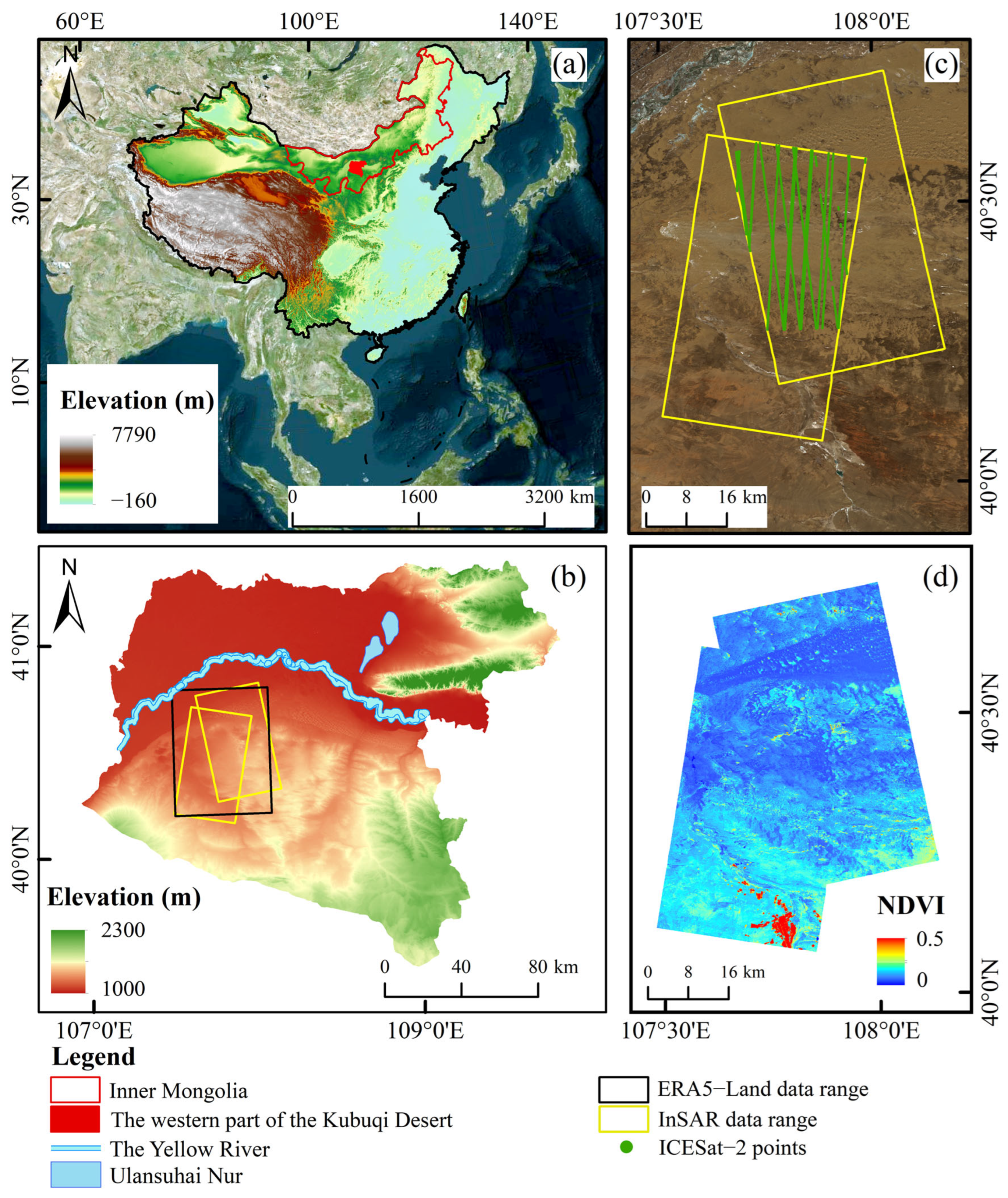
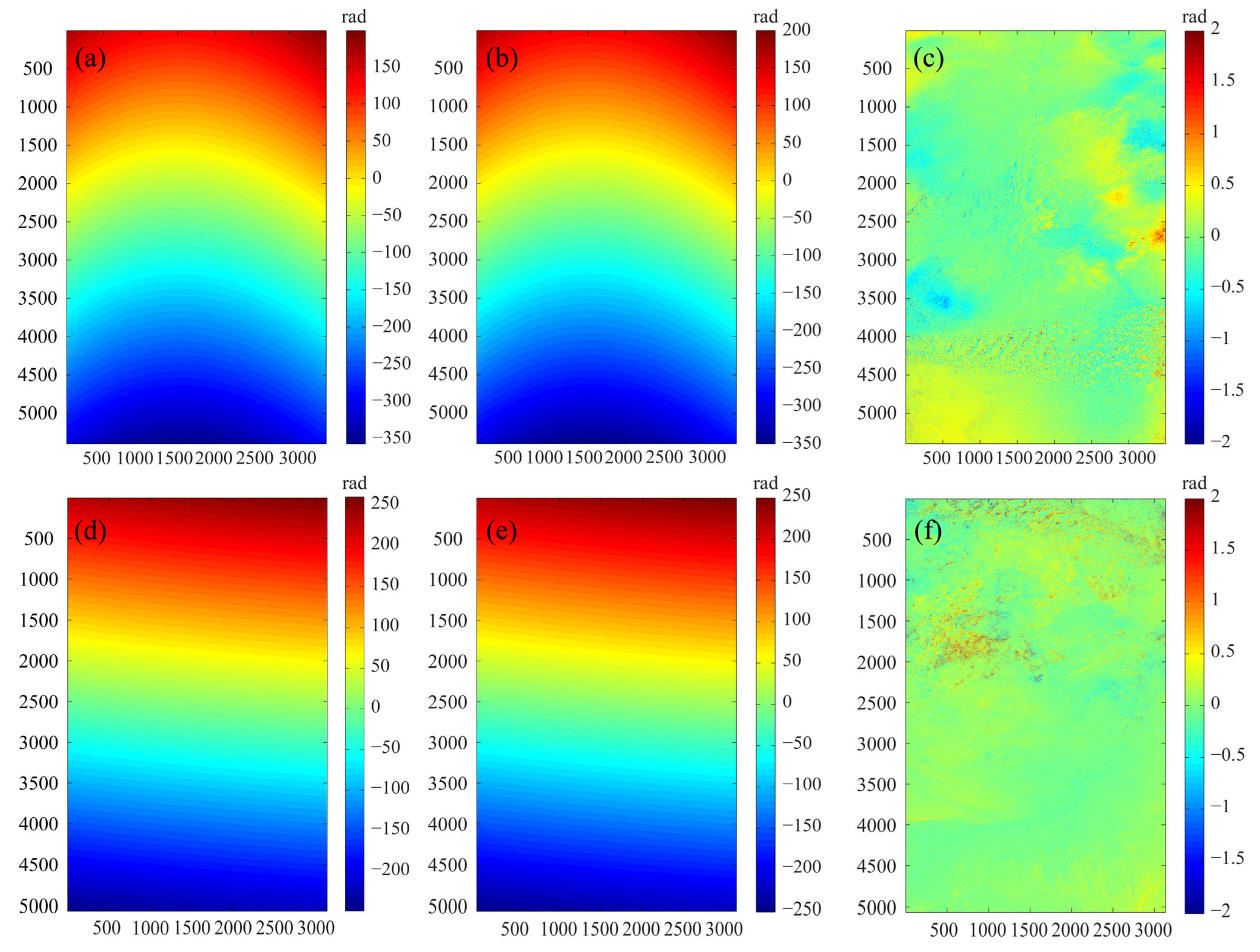

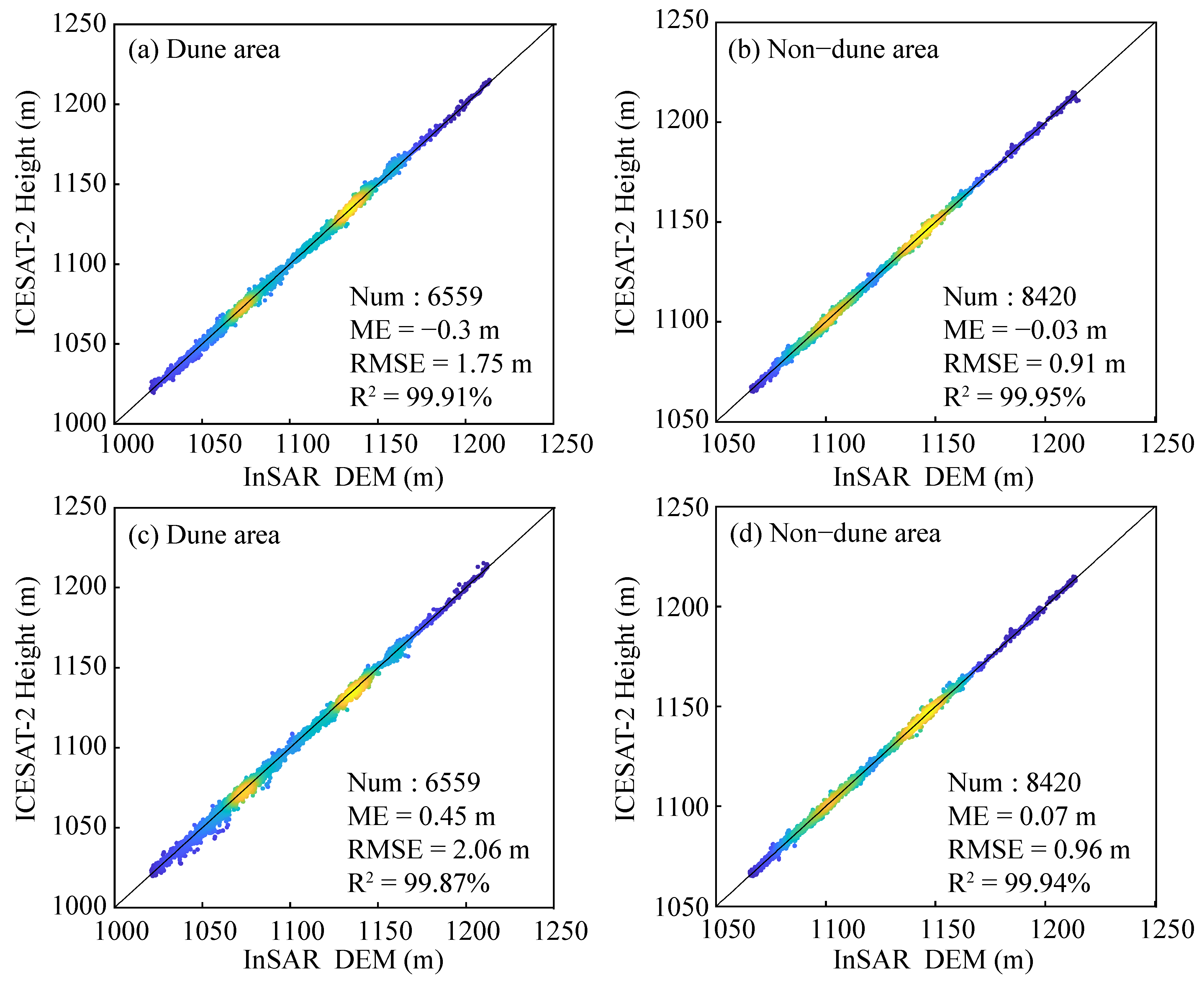
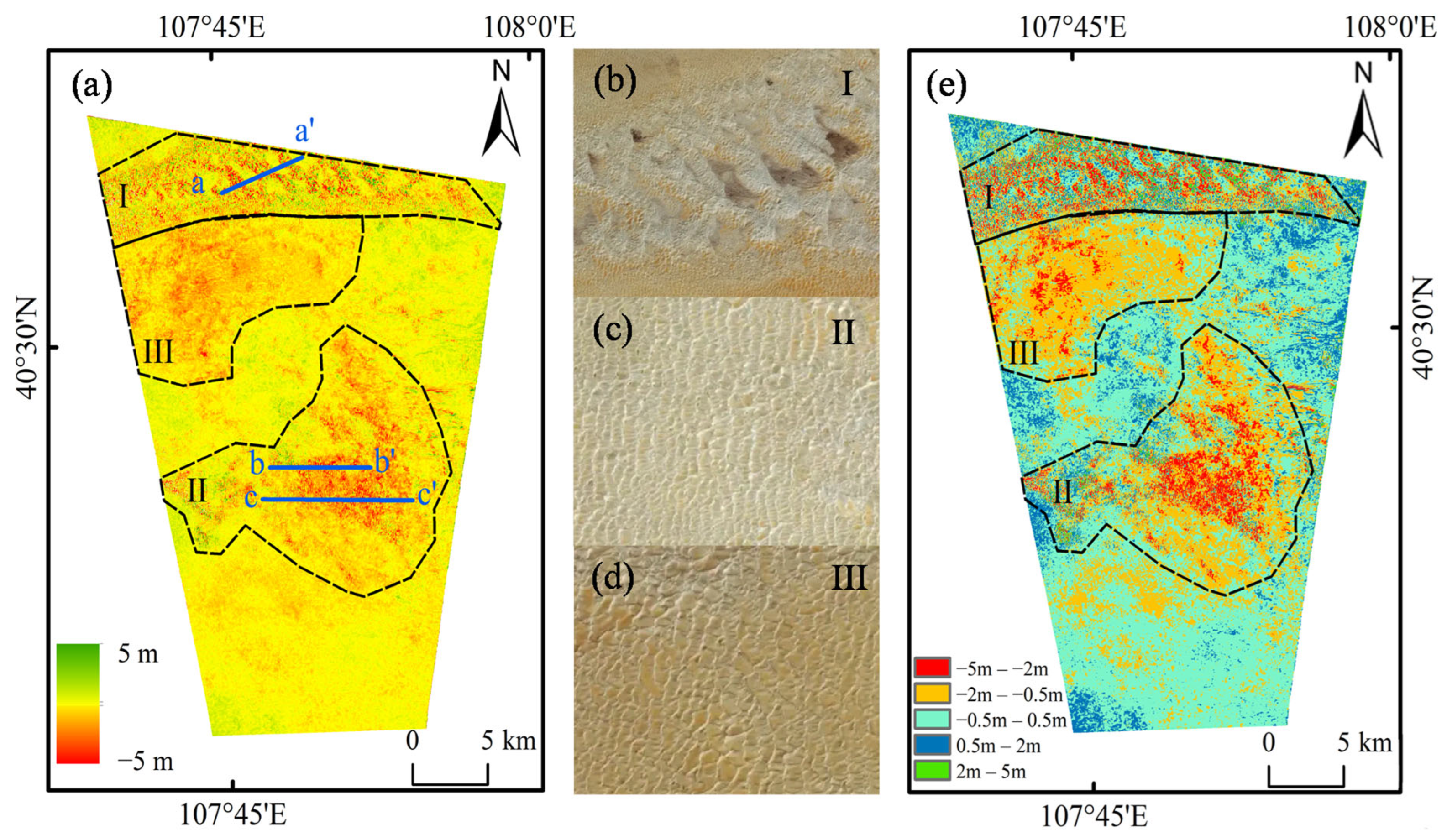
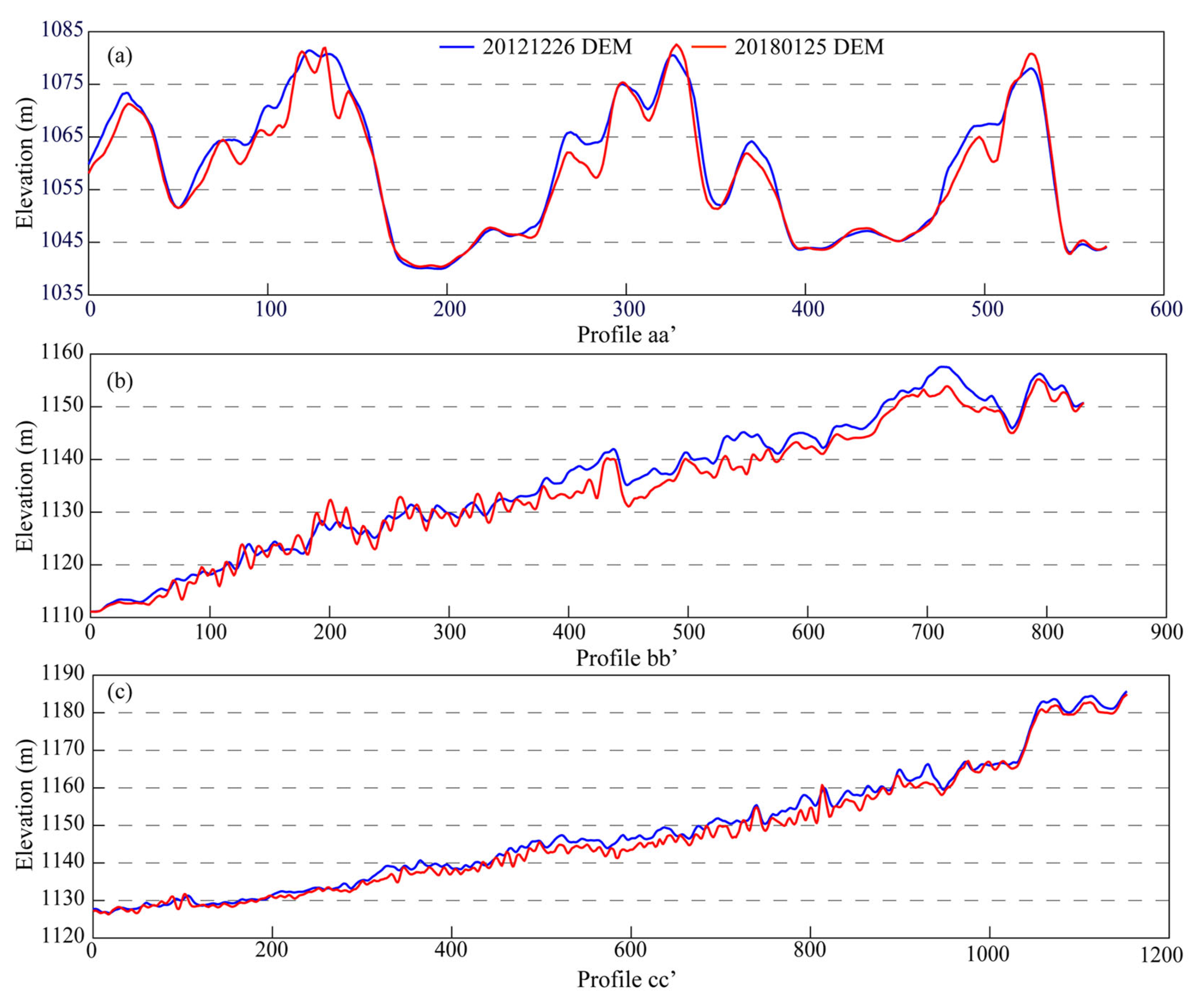


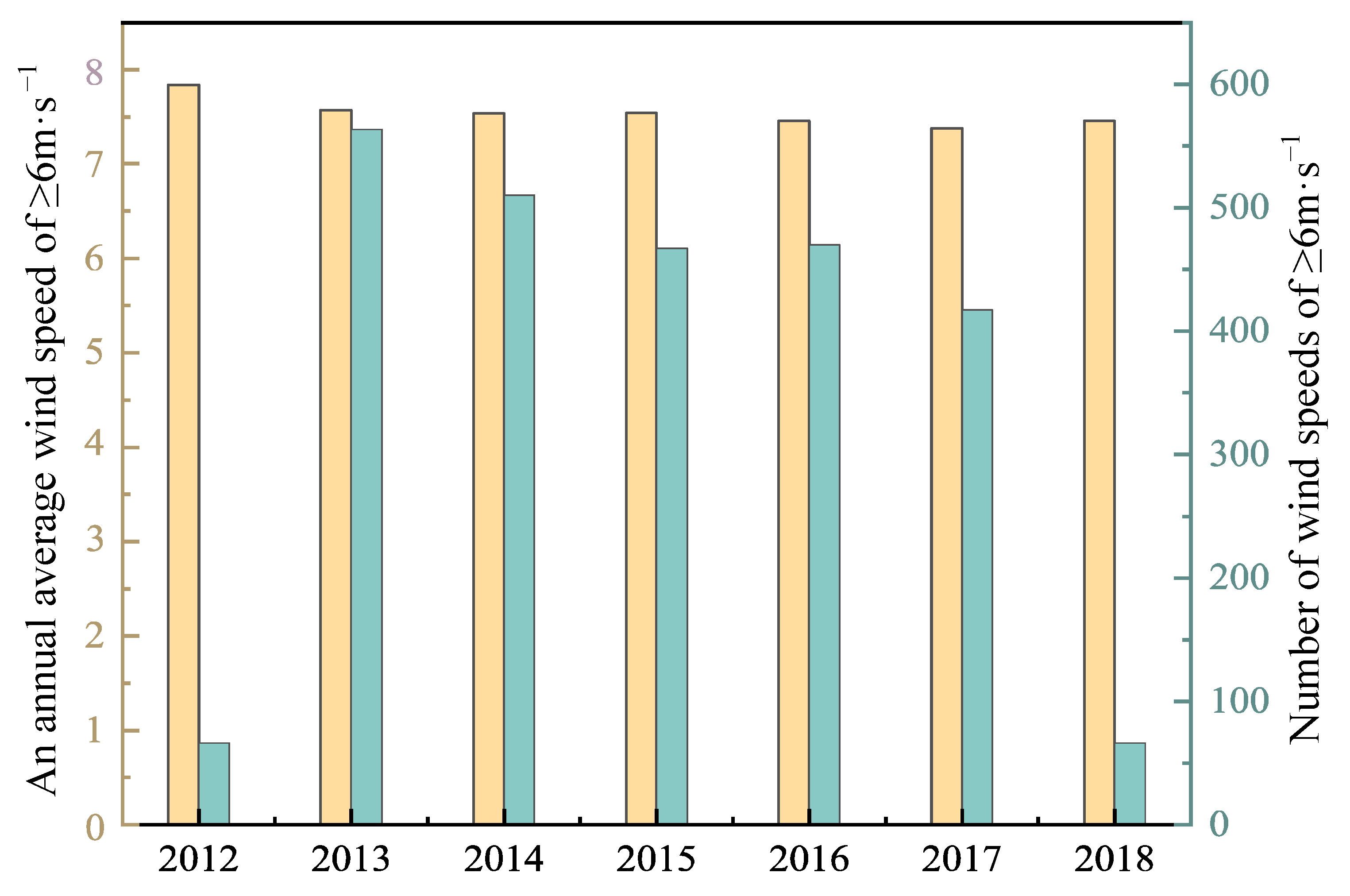
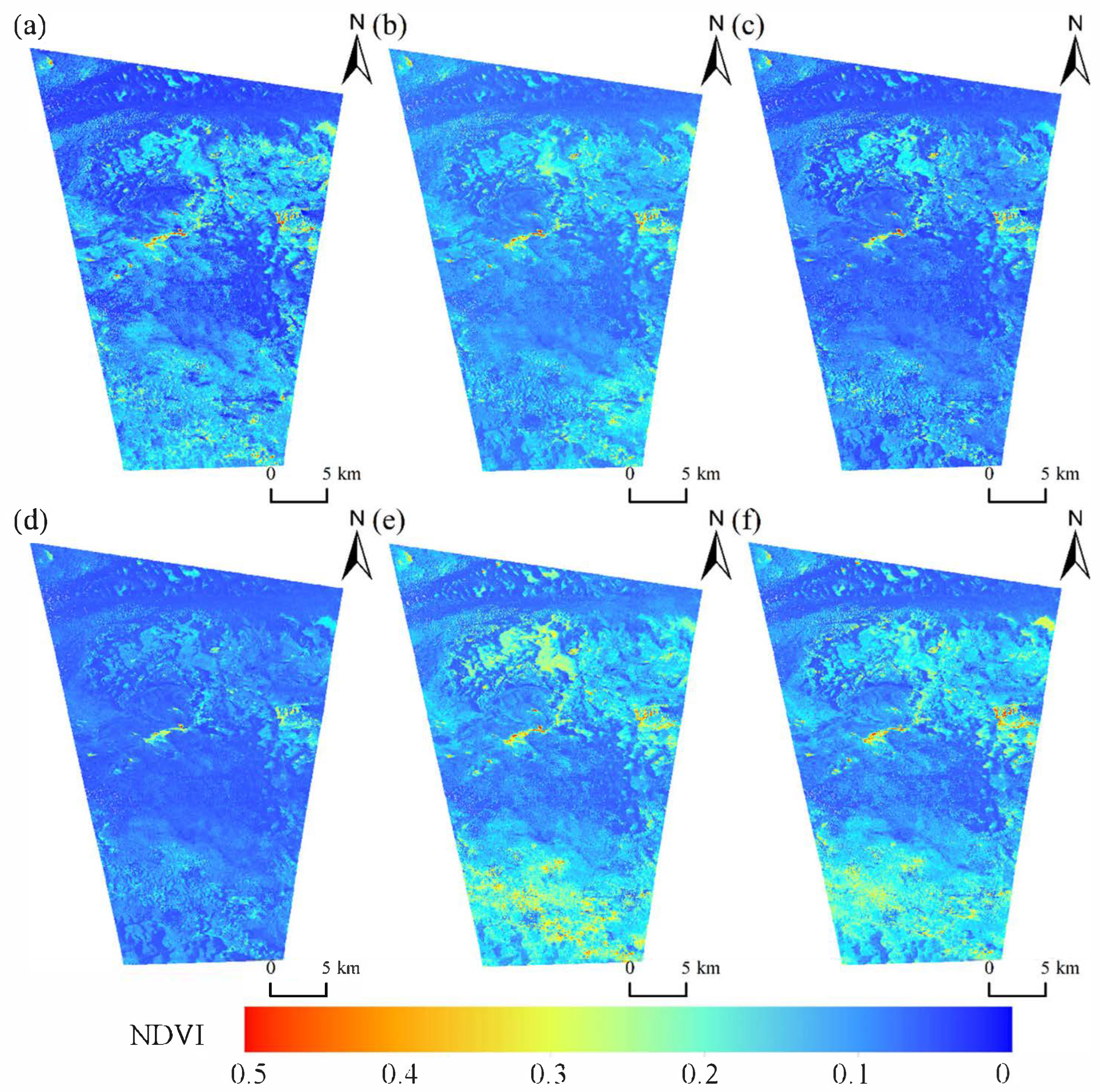


| Acquisition Date | 26 December 2012 | 25 January 2018 | |
|---|---|---|---|
| SAR parameters | (Perpendicular baseline) | −150.16 m | 124.12 m |
| Resolution | 10 m | 10 m | |
| θ (Incidence angle) | 34.69° | 32.31° | |
| R (Slant range) | 613.29 km | 597.94 km |
Disclaimer/Publisher’s Note: The statements, opinions and data contained in all publications are solely those of the individual author(s) and contributor(s) and not of MDPI and/or the editor(s). MDPI and/or the editor(s) disclaim responsibility for any injury to people or property resulting from any ideas, methods, instructions or products referred to in the content. |
© 2025 by the authors. Licensee MDPI, Basel, Switzerland. This article is an open access article distributed under the terms and conditions of the Creative Commons Attribution (CC BY) license (https://creativecommons.org/licenses/by/4.0/).
Share and Cite
Li, C.; Wang, H.; Li, R.; Yu, Y.; Miao, C.; Wang, N. Monitoring Sand Dune Height Change in Kubuqi Desert Based on a Bistatic InSAR-Measured DEM Differential Method. Remote Sens. 2025, 17, 3779. https://doi.org/10.3390/rs17223779
Li C, Wang H, Li R, Yu Y, Miao C, Wang N. Monitoring Sand Dune Height Change in Kubuqi Desert Based on a Bistatic InSAR-Measured DEM Differential Method. Remote Sensing. 2025; 17(22):3779. https://doi.org/10.3390/rs17223779
Chicago/Turabian StyleLi, Chenchen, Huiqiang Wang, Ruiping Li, Yanan Yu, Cunli Miao, and Ning Wang. 2025. "Monitoring Sand Dune Height Change in Kubuqi Desert Based on a Bistatic InSAR-Measured DEM Differential Method" Remote Sensing 17, no. 22: 3779. https://doi.org/10.3390/rs17223779
APA StyleLi, C., Wang, H., Li, R., Yu, Y., Miao, C., & Wang, N. (2025). Monitoring Sand Dune Height Change in Kubuqi Desert Based on a Bistatic InSAR-Measured DEM Differential Method. Remote Sensing, 17(22), 3779. https://doi.org/10.3390/rs17223779





